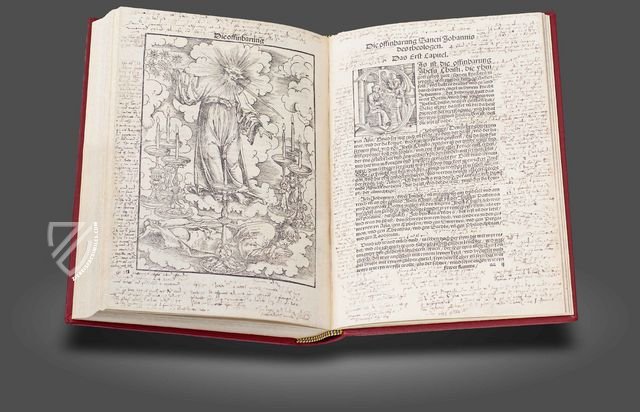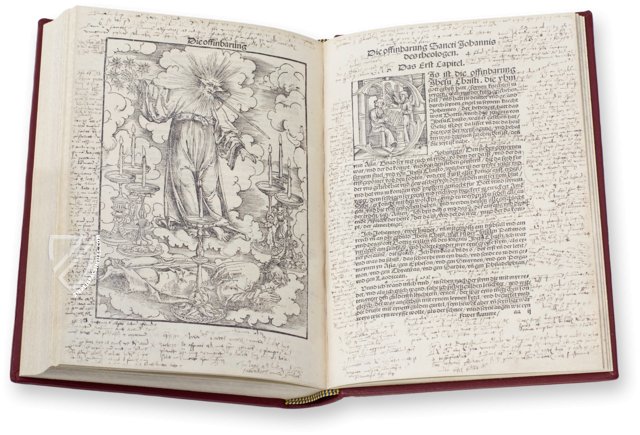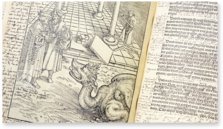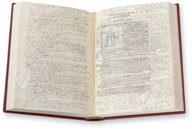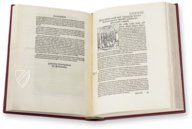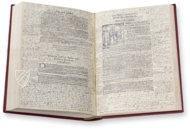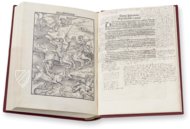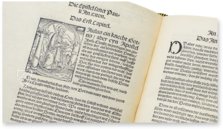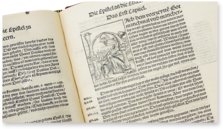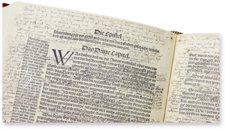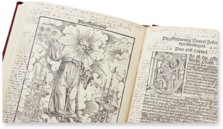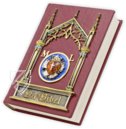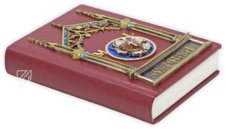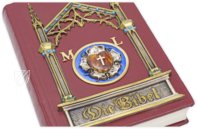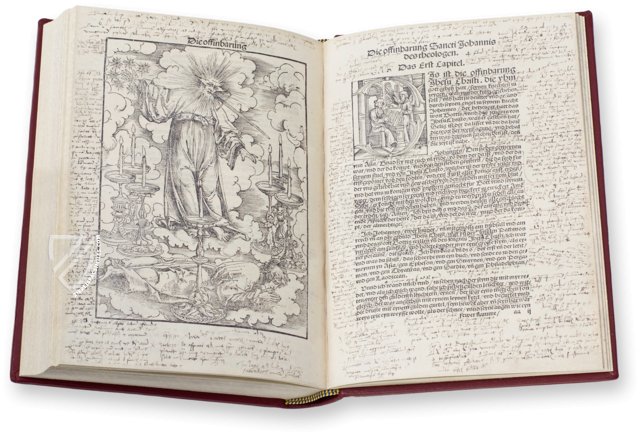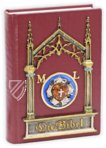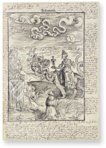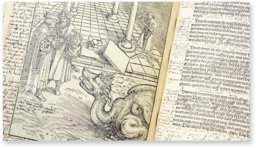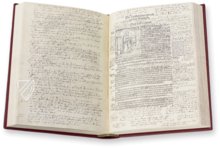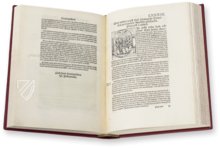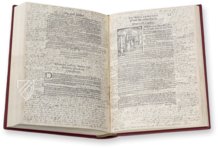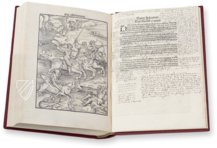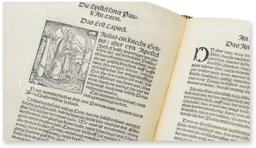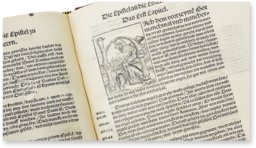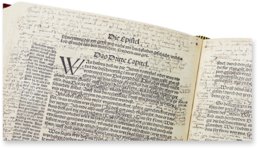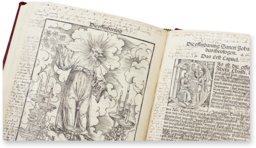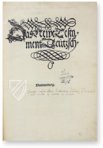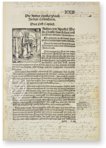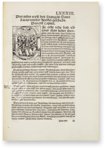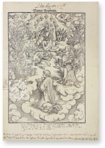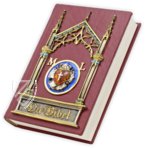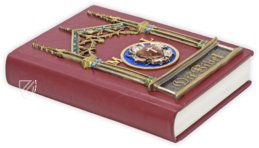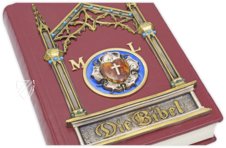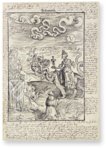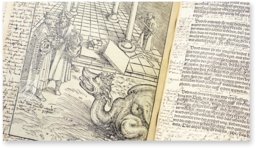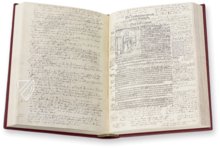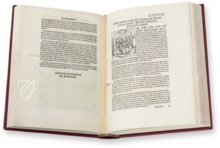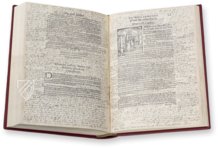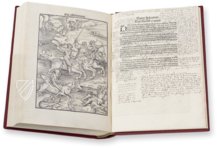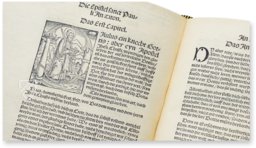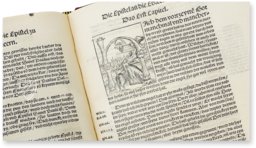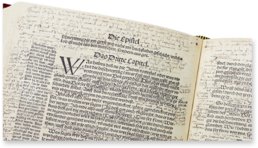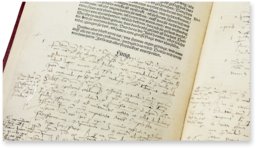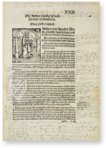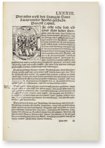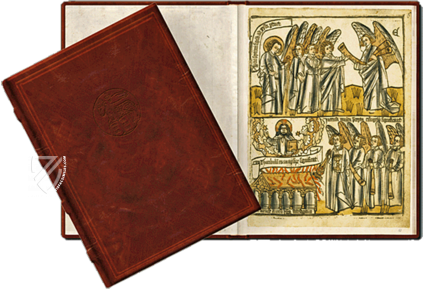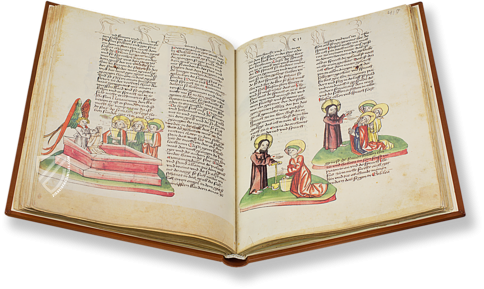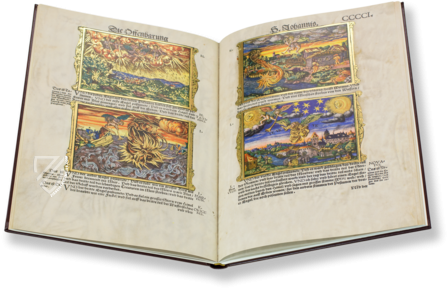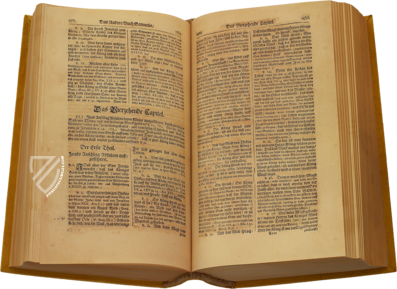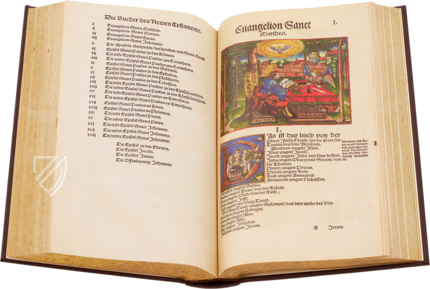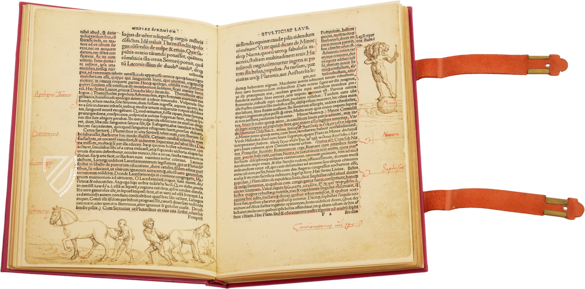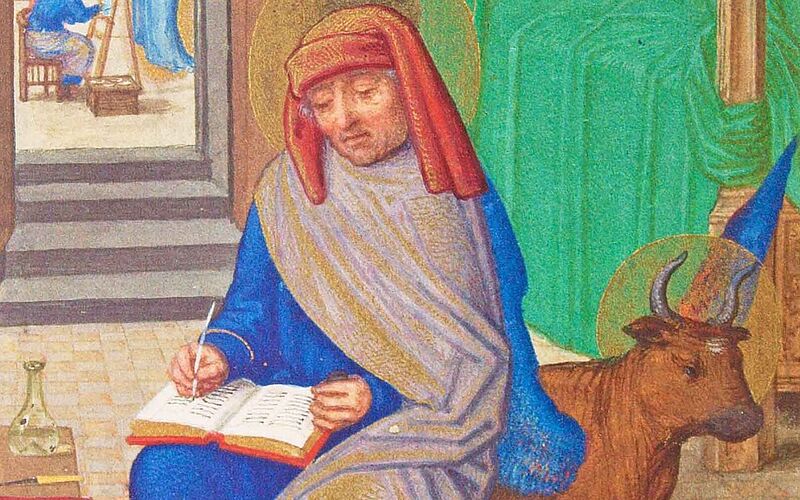Martin Luther’s September Bible from 1522
(1,000€ - 3,000€)
Although Martin Luther is best known for his Ninety-Five Theses, his most influential work is arguably his translation of the Bible into German that the common people could understand. Paired with Gutenberg's invention of the printing press, Luther’s Bible from 1522, sometimes called the September Bible proved to be a fundamental turning point in Germany’s religious, linguistic, and social history. Published in its entirety for the first time in 1534, Luther’s translation from Greek was more accurate than previous translations from the Vulgate and served as the foundation for a common German language that transcended its manifold dialects. The codex housed in the library of the Nicolaus Copernicus University in Torun, Poland was decorated with full-page woodcuts by Lucas Cranach and was the personal possession of Johann Gramann, the “Apostle of Prussia”, who was a supporter and contemporary of Luther’s. The margins of the pages are completely filled with his notes, many of them resulting from his conversations with Luther himself.
Luther’s September Bible from 1522
Martin Luther (1483–1546) is one of the most influential figures in the history of the West – not only did he ignite the Reformation with his Ninety-Five Theses, but he is also considered to be the father of modern High German due to his groundbreaking translation of the Bible, sometimes called the September Bible or the Luther Bible. The New Testament was printed in 1522, just five years after he kicked off controversy within Christendom that would boil over into the Thirty Years War. It would be followed in 1534 by a complete translation of the Bible. His translation was an unprecedented contribution to the German language. Unlike earlier German translations of the Vulgate, which were essentially translations of translations, Luther made his translation directly from the Greek text. The widespread dissemination of this edition (thanks to the printing press) not only freed the German faithful from the clerical monopoly on the word of God, but it began to establish a common German language and sense of shared identity.
Luther’s First Bible
Luther was forced to go into hiding following his excommunication by Pope Leo X in 1521 and found refuge in Wartburg Castle. While there, Luther dedicated himself to the creation of a vernacular Bible that was translated from Greek, which would be more accurate than translations from the Vulgate in addition to being more accessible to commoners and the laity as a whole. The fruits of his labor were published soon thereafter with the New Testament being published in 1522 and the entire Bible in 1534. Luther could never have had such success with his Bible were it not for the invention of the printing press: the first edition of 3,000 copies sold out in spite of its relatively high price – 1.5 Gulden. It would be followed by many more.
Linguistic Significance of Luther’s Translation
“You need to listen to the mothers walking on the roads, the children on the streets, ask ordinary people in the markets and look at their faces, listen to the way they are talking, and base your translation on it!”
– Luther on his philosophy in creating his German language Bible
At the center of Luther’s reforming vision was the removal of all barriers between the faithful and the word of God, be they hierarchical or linguistic. Although scarcely known by most people, Latin was a useful tool allowing intellectuals from across Europe to understand one another. However, it kept the common people from reading the Bible themselves, and although earlier translations of the Bible into German existed, they were imperfect, archaic, and did not reflect the way common people spoke. This was further complicated by the fact that medieval German was less of a language and more of a galaxy of dialects such as Franconian, Bavarian, Alemannic, Swabian, and Saxon inter alia that were largely incomprehensible to one another. The problem was so acute that there were traveler’s dictionaries for medieval Germans venturing through other German lands. Luther’s translation, based on the Saxon dialect, created the foundation upon which modern High German was built. His creation of a common language, with the help of the printing press, helped to craft a sense of national identity in Germany in addition to cultural norms concerning law and morality. Furthermore, Luther’s vernacular translation inspired a wave of vernacular translations across Europe, extending the reach of his influence far beyond the borders of the German-speaking world.
Marginal Notes from Conversations with Luther
Johann Gramann – also known as the “Apostle of Prussia” – was a follower and co-reformer of Martin Luther who had his own personal copy of the first edition of the September Bible, printed by Melchior Lotter of Leipzig. Decorated with woodcuts by the great Lucas Cranach, his copy is filled to the brim with marginal notes, many of them resulting from his own conversations with Luther himself. The oft-tangled appearance of these notes belies their importance as a firsthand account of Luther’s lectures and discussions from another prominent theologian and scholar. This is a testimonial to some of the most fortuitous events in history, the ideas being developed here had both positive consequences in advancing Western thought, and negative ones in the devastating religious conflicts that introduced a new level of violence to the civilian populations of Europe. Housed today in the library of Nicolaus Copernicus University in Torun, Poland, it is an incredibly important artifact of both the Reformation and the roots of the modern German language.
Masterfully Engraved Woodcuts by Lucas Cranach
Lucas Cranach was a painter, portraitist, engraver of woodcuts, and printer who was talented and prolific in equal measure. He was in the employ of the Electors of Saxony for most of his life, but also worked for a number of other patrons and is best known for his portraits of Protestant noblemen. Born in Franconia ca. 1472, his work attracted the attention of Duke Friedrich III, Elector of Saxony and he was subsequently brought to court in 1504. Cranach travelled to the Netherlands in 1509 where he painted portraits of Emperor Maximillian I and his son, who would eventually become known as Charles V. Like his patrons, the Dukes of Saxony, Cranach was friendly to Protestantism early on and became personal friends with Martin Luther, whom he first depicted in a woodcut in 1520 and would portray in numerous portraits. He collaborated with Luther on the production of the September Bible and masterfully engraved the woodcuts for the miniatures accompanying the groundbreaking text. Cranach died in Weimar in 1553 at the ripe old age of 81 and is an ancestor of the great Johann Wolfgang von Goethe through his daughter Barbara.
Codicology
- Alternative Titles
- September Bibel
Septemberbibel
September Testament
Martin Luther: September Bibel - Size / Format
- 444 pages / 30.0 × 22.0 cm
- Origin
- Germany
- Date
- 1522
- Epochs
- Style
- Genre
- Language
- Illustrations
- 21 woodcuts by Lucas Cranach the Older
- Content
- New Testament
- Patron
- Johann Gramann, Apostle of Prussia
- Artist / School
- Lucas Cranach the Older (woodcuts)
Melchior Lotter of Leipzig (printer) - Previous Owners
- Johann Gramann, Apostle of Prussia
Martin Luther’s September Bible from 1522
The Vision of John of Patmos
Crowned by seven torches and flanked by the Four Evangelist Symbols, the unspecified “Son of Man” from Rev. 1:13 is depicted here surrounded by angels playing harps in Heaven. Although most modern scholars agree that the author of the Book of Revelation was a certain John of Patmos, during the Middle Ages it was still believed that it was the work of John the Evangelist. John wrote the Book of Revelation while on the Greek island of Patmos, where he was supposedly exiled by the Roman Emperor Domitian.
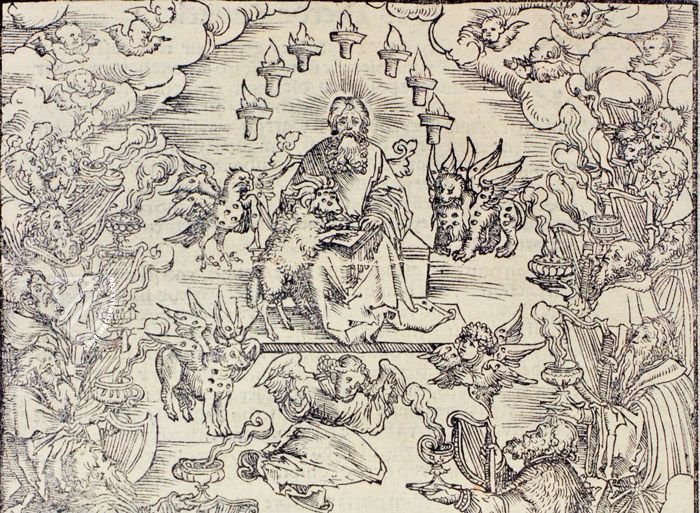
Martin Luther’s September Bible from 1522
The Whore of Babylon
“So he carried me away in the Spirit into the wilderness. And I saw a woman sitting on a scarlet beast which was full of names of blasphemy, having seven heads and ten horns. The woman was arrayed in purple and scarlet, and adorned with gold and precious stones and pearls, having in her hand a golden cup full of abominations and the filthiness of her fornication.” Rev. 17:3-4.
An angel who shows John this image explains to him that this is Babylon, the Mother of Harlots, who is drunk on the blood of martyrs i.e. persecution of the faithful. The horns of the beast represent the kings ruling the Earth who give power to her until they rise up and overthrow her. Notes from the hand of Johann Gramann concerning the dense imagery of this woodcut fill the margins.

#1 September Bible (Luxury Edition)
(1,000€ - 3,000€)
#2 September Bible (Library Edition)
(1,000€ - 3,000€)
- Treatises / Secular Books
- Apocalypses / Beatus
- Astronomy / Astrology
- Bestiaries
- Bibles / Gospels
- Chronicles / History / Law
- Geography / Maps
- Saints' Lives
- Islam / Oriental
- Judaism / Hebrew
- Single Leaf Collections
- Leonardo da Vinci
- Literature / Poetry
- Liturgical Manuscripts
- Medicine / Botany / Alchemy
- Music
- Mythology / Prophecies
- Psalters
- Other Religious Books
- Games / Hunting
- Private Devotion Books
- Other Genres
- Afghanistan
- Armenia
- Austria
- Belgium
- Belize
- Bosnia and Herzegovina
- China
- Colombia
- Costa Rica
- Croatia
- Cyprus
- Czech Republic
- Denmark
- Egypt
- El Salvador
- Ethiopia
- France
- Germany
- Greece
- Guatemala
- Honduras
- Hungary
- India
- Iran
- Iraq
- Israel
- Italy
- Japan
- Jordan
- Kazakhstan
- Kyrgyzstan
- Lebanon
- Liechtenstein
- Luxembourg
- Mexico
- Morocco
- Netherlands
- Palestine
- Panama
- Peru
- Poland
- Portugal
- Romania
- Russia
- Serbia
- Spain
- Sri Lanka
- Sweden
- Switzerland
- Syria
- Tajikistan
- Turkey
- Turkmenistan
- Ukraine
- United Kingdom
- United States
- Uzbekistan
- Vatican City
- A. Oosthoek, van Holkema & Warendorf
- Aboca Museum
- Ajuntament de Valencia
- Akademie Verlag
- Akademische Druck- u. Verlagsanstalt (ADEVA)
- Aldo Ausilio Editore - Bottega d’Erasmo
- Alecto Historical Editions
- Alkuin Verlag
- Almqvist & Wiksell
- Amilcare Pizzi
- Andreas & Andreas Verlagsbuchhandlung
- Archa 90
- Archiv Verlag
- Archivi Edizioni
- Arnold Verlag
- ARS
- Ars Magna
- ArtCodex
- AyN Ediciones
- Azimuth Editions
- Badenia Verlag
- Bärenreiter-Verlag
- Belser Verlag
- Belser Verlag / WK Wertkontor
- Benziger Verlag
- Bernardinum Wydawnictwo
- BiblioGemma
- Biblioteca Apostolica Vaticana (Vaticanstadt, Vaticanstadt)
- Bibliotheca Palatina Faksimile Verlag
- Bibliotheca Rara
- Boydell & Brewer
- Bramante Edizioni
- Bredius Genootschap
- Brepols Publishers
- British Library
- C. Weckesser
- Caixa Catalunya
- Canesi
- CAPSA, Ars Scriptoria
- Caratzas Brothers, Publishers
- Carus Verlag
- Casamassima Libri
- Centrum Cartographie Verlag GmbH
- Chavane Verlag
- Christian Brandstätter Verlag
- Circulo Cientifico
- Club Bibliófilo Versol
- Club du Livre
- CM Editores
- Collegium Graphicum
- Collezione Apocrifa Da Vinci
- Comissão Nacional para as Comemorações dos Descobrimentos Portugueses
- Coron Verlag
- Corvina
- CTHS
- D. S. Brewer
- Damon
- De Agostini/UTET
- De Nederlandsche Boekhandel
- De Schutter
- Deuschle & Stemmle
- Deutscher Verlag für Kunstwissenschaft
- DIAMM
- Droz
- E. Schreiber Graphische Kunstanstalten
- Ediciones Boreal
- Ediciones Grial
- Ediclube
- Edições Inapa
- Edilan
- Editalia
- Edition Deuschle
- Edition Georg Popp
- Edition Leipzig
- Edition Libri Illustri
- Editiones Reales Sitios S. L.
- Éditions de l'Oiseau Lyre
- Editions Medicina Rara
- Editorial Casariego
- Editorial Mintzoa
- Editrice Antenore
- Editrice Velar
- Edizioni Edison
- Egeria, S.L.
- Eikon Editores
- Electa
- Emery Walker Limited
- Enciclopèdia Catalana
- Eos-Verlag
- Ephesus Publishing
- Ernst Battenberg
- Eugrammia Press
- Extraordinary Editions
- Fackelverlag
- Facsimila Art & Edition
- Facsimile Editions Ltd.
- Facsimilia Art & Edition Ebert KG
- Faksimile Verlag
- Feuermann Verlag
- Folger Shakespeare Library
- Franco Cosimo Panini Editore
- Friedrich Wittig Verlag
- Fundación Hullera Vasco-Leonesa
- G. Braziller
- Gabriele Mazzotta Editore
- Gebr. Mann Verlag
- Gesellschaft für graphische Industrie
- Getty Research Institute
- Giovanni Domenico de Rossi
- Giunti Editore
- Graffiti
- Grafica European Center of Fine Arts
- Guido Pressler
- Guillermo Blazquez
- Gustav Kiepenheuer
- H. N. Abrams
- Harrassowitz
- Harvard University Press
- Helikon
- Hendrickson Publishers
- Henning Oppermann
- Herder Verlag
- Hes & De Graaf Publishers
- Hoepli
- Holbein-Verlag
- Houghton Library
- Hugo Schmidt Verlag
- Idion Verlag
- Il Bulino, edizioni d'arte
- ILte
- Imago
- Insel Verlag
- Insel-Verlag Anton Kippenberger
- Instituto de Estudios Altoaragoneses
- Instituto Nacional de Antropología e Historia
- Introligatornia Budnik Jerzy
- Istituto dell'Enciclopedia Italiana - Treccani
- Istituto Ellenico di Studi Bizantini e Postbizantini
- Istituto Geografico De Agostini
- Istituto Poligrafico e Zecca dello Stato
- Italarte Art Establishments
- Jan Thorbecke Verlag
- Johnson Reprint Corporation
- Josef Stocker
- Josef Stocker-Schmid
- Jugoslavija
- Karl W. Hiersemann
- Kasper Straube
- Kaydeda Ediciones
- Kindler Verlag / Coron Verlag
- Kodansha International Ltd.
- Konrad Kölbl Verlag
- Kurt Wolff Verlag
- La Liberia dello Stato
- La Linea Editrice
- La Meta Editore
- Lambert Schneider
- Landeskreditbank Baden-Württemberg
- Leo S. Olschki
- Les Incunables
- Liber Artis
- Library of Congress
- Libreria Musicale Italiana
- Lichtdruck
- Lito Immagine Editore
- Lumen Artis
- Lund Humphries
- M. Moleiro Editor
- Maison des Sciences de l'homme et de la société de Poitiers
- Manuscriptum
- Martinus Nijhoff
- Maruzen-Yushodo Co. Ltd.
- MASA
- Massada Publishers
- McGraw-Hill
- Metropolitan Museum of Art
- Militos
- Millennium Liber
- Müller & Schindler
- Nahar - Stavit
- Nahar and Steimatzky
- National Library of Wales
- Neri Pozza
- Nova Charta
- Oceanum Verlag
- Odeon
- Orbis Mediaevalis
- Orbis Pictus
- Österreichische Staatsdruckerei
- Oxford University Press
- Pageant Books
- Parzellers Buchverlag
- Patrimonio Ediciones
- Pattloch Verlag
- PIAF
- Pieper Verlag
- Plon-Nourrit et cie
- Poligrafiche Bolis
- Presses Universitaires de Strasbourg
- Prestel Verlag
- Princeton University Press
- Prisma Verlag
- Priuli & Verlucca, editori
- Pro Sport Verlag
- Propyläen Verlag
- Pytheas Books
- Quaternio Verlag Luzern
- Reales Sitios
- Recht-Verlag
- Reichert Verlag
- Reichsdruckerei
- Reprint Verlag
- Riehn & Reusch
- Roberto Vattori Editore
- Rosenkilde and Bagger
- Roxburghe Club
- Salerno Editrice
- Saltellus Press
- Sandoz
- Sarajevo Svjetlost
- Schöck ArtPrint Kft.
- Schulsinger Brothers
- Scolar Press
- Scrinium
- Scripta Maneant
- Scriptorium
- Shazar
- Siloé, arte y bibliofilia
- SISMEL - Edizioni del Galluzzo
- Sociedad Mexicana de Antropología
- Société des Bibliophiles & Iconophiles de Belgique
- Soncin Publishing
- Sorli Ediciones
- Stainer and Bell
- Studer
- Styria Verlag
- Sumptibus Pragopress
- Szegedi Tudomànyegyetem
- Taberna Libraria
- Tarshish Books
- Taschen
- Tempus Libri
- Testimonio Compañía Editorial
- Thames and Hudson
- The Clear Vue Publishing Partnership Limited
- The Facsimile Codex
- The Folio Society
- The Marquess of Normanby
- The Richard III and Yorkist History Trust
- Tip.Le.Co
- TouchArt
- TREC Publishing House
- TRI Publishing Co.
- Trident Editore
- Tuliba Collection
- Typis Regiae Officinae Polygraphicae
- Union Verlag Berlin
- Universidad de Granada
- University of California Press
- University of Chicago Press
- Urs Graf
- Vallecchi
- Van Wijnen
- VCH, Acta Humaniora
- VDI Verlag
- VEB Deutscher Verlag für Musik
- Verlag Anton Pustet / Andreas Verlag
- Verlag Bibliophile Drucke Josef Stocker
- Verlag der Münchner Drucke
- Verlag für Regionalgeschichte
- Verlag Styria
- Vicent Garcia Editores
- W. Turnowski Ltd.
- W. Turnowsky
- Waanders Printers
- Wiener Mechitharisten-Congregation (Wien, Österreich)
- Wissenschaftliche Buchgesellschaft
- Wissenschaftliche Verlagsgesellschaft
- Wydawnictwo Dolnoslaskie
- Xuntanza Editorial
- Zakład Narodowy
- Zollikofer AG

